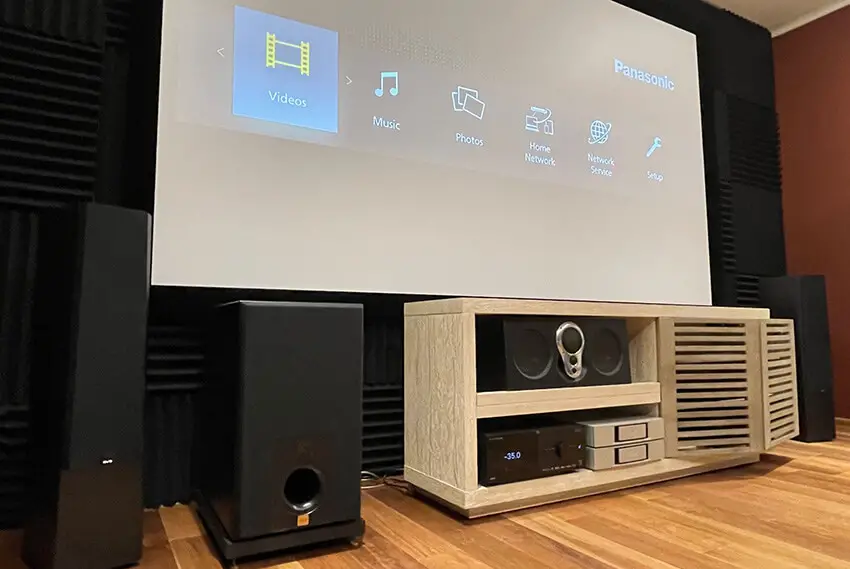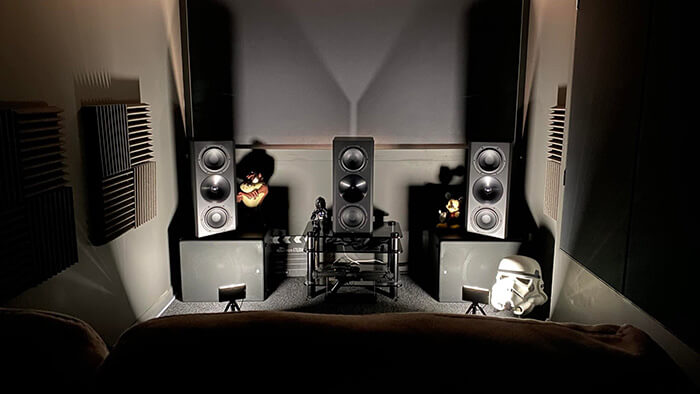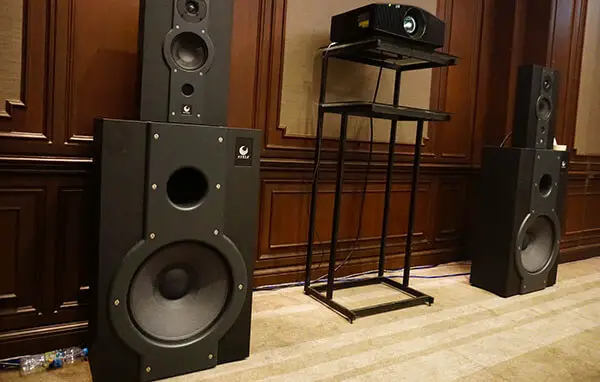Connecting multiple speakers is no cup of tea. To be able to correctly insert the color-coded speaker wires to the right outputs can get very confusing. It’s not unusual to be scratching your head in confusion at this point.
If your speaker has a wire combination of silver and copper, figuring out which one’s positive and which one’s negative can be tricky as both of the elements are incredibly different from each other. Compared to copper, silver has very less resistivity but feels more dense and has the highest electrical conductivity of all metals. On the other hand, copper is more malleable and ductile than silver, making it easy to twist, resize and bend the shape of copper wires.
Amidst all such differences, how do you know which speaker wire is copper and which one’s silver? More importantly, how will you find out which wire should go to the positive terminal and which one shall go into the negative terminal?
Don’t stress yourself out as in this article, once and for all, we’re going to clear the fog on the polarity of copper and silver speaker wires to save you from the misery of experiencing poor audio quality due to improper wiring. So, grab a seat and keep scrolling down.

How to Determine Which Speaker Wire is Positive or Negative?
Okay, apologies in advance for bursting your bubbles, but you need to realize this bitter truth – there is no positive or negative speaker wire.
Sounds or audio are sinusoidal (meaning, the current alternates between positive and negative). On the contrary, DC current (like in a battery) has specified positive and negative connections.
The main reason for one wire to be colored differently from the other is to make the distinguishing job easier – so that you can connect two or more speakers together correctly. The wires are not colored differently to indicate which one’s positive and which one’s negative to the user.
Let’s understand the basic chemistry behind why silver wires and copper wires don’t have a positive or negative charge inherently. When it comes to a speaker wire, its positive and negative charges solely depend on the electrical current flowing through the wire. The convention is to use red wire for the positive terminal and black wire for the negative terminal, but the color of the wire does not determine its charge.
Nevertheless, there are still some universal clues and physical properties that will help you identify which wire to connect to the positive terminal of your speakers and which wire should go into the negative terminal. Let’s explore some of these clues:
1. Stripes on Wires
Although this hack may not work in the case of all speaker models of all brands, it is still a very useful technique to distinguish the polarity of two similar-looking wires.
The first step is to look for any stripes present on the wires. It may be the case that one of the wires is completely black or of just one solid color, but the other wire is white-striped or red-striped. In this case, we will consider the plain single-colored wire to be negative and the wire with multi-colored stripes and markings to be positive.
2. Color Combinations
You must have observed by now that all your speakers have wires of different color combinations, you’ll never find a speaker model that has absolutely identical speaker wires in terms of colors and design, otherwise, it would be impossible to distinguish which one’s positive and which one’s negative.
Let’s look at some of the common color combinations:
1. Black and Red:
Many speaker models come with wire combinations of black and red. In this case, the black wire is negative and the red wire will be positive.
2. Silver and Copper:
If your speaker wires have a combination of silver and copper, the copper wire is more likely to be negative and the silver one is positive.
3. Black and White:
Just like how the color white represents peace, purity, and positivity, your white speaker wire is also positive and the black wire will be negative.
4. Blue and Gray
If your speaker features blue and gray wires for connecting, usually the blue wire turns out to be positive and the gray wire is negative.
5. Green and Blue
Some speaker wires may have a unique color combination of green and blue. In such cases, the blue one is more likely to be positive and the green wire may be negative.
3. User’s Manual Booklet
Just a heads up – it’s not possible for us to give you a 100% guarantee that our speculations about an individual wire’s polarity based on the color combinations we discussed will work out for you. We only illustrated the possibilities based on our long-term experiences with speaker wires. Although we mentioned that the green wires are more likely to be negative, the green wire on your speaker could actually rather be positive.
Therefore, for complete assurance and absolute authentic information, you should check out the User’s Guide booklet given to you by the manufacturers of your speaker model. Which speaker is positive and which speaker should be inserted into the negative terminal – all this info will be stated in that booklet.
If you’ve lost yours, you can also download the pdf version from the official website of your speaker company.
4. Test with a 9V Battery
To be more assured, you can conduct a small experiment within the comfort of your home and find out which speaker wire is positive. To do this test, all you need is a 9V AAA battery.
Step 1: Grab a 9-volt AAA battery and a battery clip with positive (red) and negative (black) wires.
Step 2: Out of both the speaker wires, try to make a wild guess about which one’s likely to be the negative wire.
Step 3: Then take that wire which appears to be negative to you and connect one end of the wire to the speaker and connect the positive wire of the battery clip to the speaker.
If this turns out to be the proper polarity of the two speaker choices, meaning – if the wire you selected is really negative, then you’re going to hear a scratching noise. On the other hand, if you don’t hear anything, no sounds whatsoever, that’s probably because your guess was wrong and the wire is actually positive.
5. Test With a Multimeter
A multimeter is a device that allows you to figure out different electrical values such as voltage, amperage etc. With this tool, you can also check your speaker wires’ polarity. You can buy a multimeter from any local hardware shop. Oh, just a heads up – you’ll need a 9V battery for this too. Once you have gathered all the necessary tools, follow these steps in order:
Step 1: Unplug the speaker wires.
Step 2: Grab the 9V battery and connect your speaker wires to the battery.
Step 3: Now, with the help of the multimeter, convert it to DC voltage.
Step 4: Next, connect a speaker wire to the multimeter and check the wire reading.
Step 5: If the multimeter reading says positive or ‘+’ that means the wire is positive and the other one is negative.
6. Use a Polarity Testing App
You may have never heard of it but a polarity testing app is a real thing. Simply grab your phone and go to Google Play Store or Apple Store and download a polarity testing app with good ratings. After the app has been installed, take a speaker wire and insert it into your smartphone’s headphone jack. Now, open the app on your phone and run it. The polarity app will use your phone’s microphone to check the sound and state the polarity.
Does Polarity Matter When It Comes To Speakers?
Honestly, the polarity doesn’t matter much if you only have one speaker. If you do end up connecting the positive wire to the negative terminal of the speaker, yes the polarity will be reversed but there will be no serious danger. You may hear little sound interruptions or slight distortions at lower frequencies here and there when streaming music – that’s all.
On the other hand, if you want to connect multiple speakers together at the same time, then yes, the polarity has to be matched correctly otherwise the audio quality will be terrible and also embarrassing in front of your guests. Not being careful and cautious about your wires’ polarity may also damage the wires or damage the amplifier in the long run.
Why Should You Use Silver and Copper Wires in Speakers?
Hmm, good question. Although both of these metals are very different from each other with opposite properties, you should still consider using them for your speakers to achieve different purposes.
For instance, silver has much better conductive properties and deals with sound impedance differently than copper. Using silver wires therefore, make it easier to accurately reproduce the source signal.
On the contrary, silver has a slightly lower resistivity than copper. Plus, copper wires are way much cheaper than silver wires given that it offers better resistance than silver.
So, now which one should you use for your speakers? We would like to take a middle-ground stand in this case and rather advise you to go for silver-plated copper wires. This is because copper is cheaper and does oxidize quickly, so, if it’s well-covered with a thin layer of silver, the insulation will be better.
Wrapping Up
Let’s do a quick recap of what we learnt in this article today. The main lesson is that the polarity of the speaker wires heavily depend on your speaker type, model and brand, simply judging from the color and design of the wires may not be accurate. Nonetheless, don’t be afraid to experiment with the wires.
Even if you’re not sure which one’s positive and which one’s negative, randomly put any speaker wire into one of the terminals and observe the sound quality. Keep doing these experiments with the wire arrangements and see which way you get the best audio quality.
Frequently Asked Questions:
1. Which speaker wire is positive, copper or silver?
Answer: The silver wire is more likely to be positive and the copper wire to be negative. Again, it really depends on the type of your speaker as the color codes vary from brand to brand.
2. Is silver good for speaker wire?
Answer: Silver is very brittle, using silver wires doesn’t give any extraordinary advantages over regular copper wires. However, silver-plated copper wires are really good and offer better conductivity.
3. Which wire is positive on the speaker wire?
Answer: The white wires, or wires with a white label, are normally the positive wires in most speakers. The entirely black or unmarked cable is usually the negative wire. If you want to be completely sure, you can perform a test with a 9-volt battery, use a polarity testing app or use a multimeter.
4. Why is copper wire better than silver?
Answer: Most people prefer buying copper wires than silver ones because copper wires are relatively cheaper – not to mention, copper also happens to be a better conductor and less magnetic than silver.




